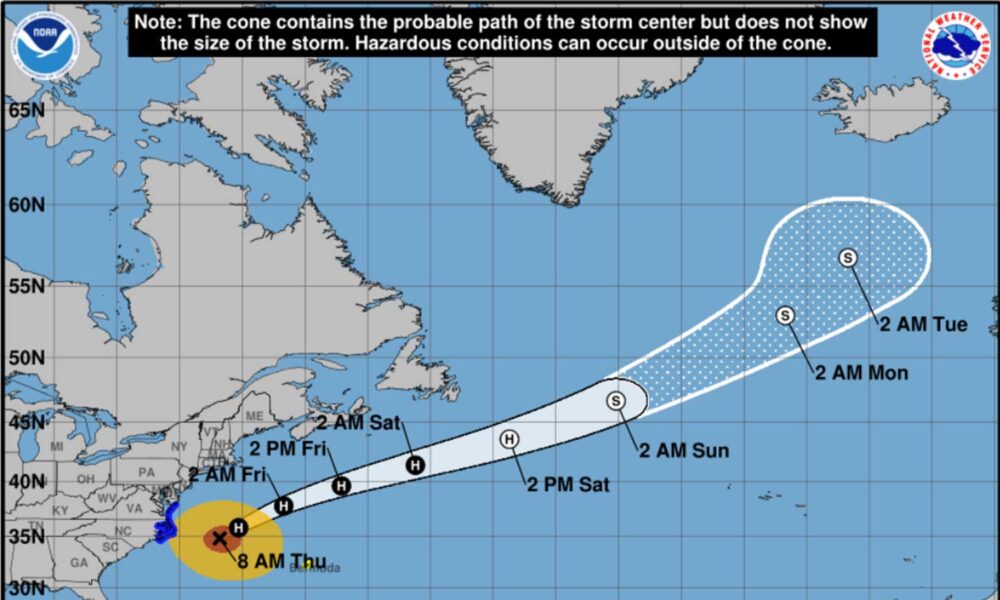Marc Alessi, Carlos Martinez, Carly Phillips and Shana Udvardy contributed to this post.
We’ve just entered the most active part of the Atlantic hurricane season, which has historically been from August to October. We have been fortunate to have seen only 4 storms and one hurricane so far. But already, there has been loss of life and millions of dollars in damage. In order to be properly prepared, we need accurate hurricane forecasts. Unfortunately, much of the work behind these forecasts is encountering some roadblocks, thanks to the Trump administration’s anti-science agenda.
Hurricane Erin: first hurricane of 2025 Atlantic Season got big fast
After forming in the Atlantic Ocean northeast of the Lesser Antilles, Hurricane Erin underwent a period of rapid intensification, defined as an increase in winds of 35 mph in a 24-hour period. But Erin did more than that: it strengthened from a Category 1 hurricane to a Category 5 hurricane in just over 24 hours (that’s an 80 mph increase in 24 hours!). In fact, Erin strengthened 45 mph in just 6 hours. It is one of the fastest rapid intensifications on record in the Atlantic Basin. As our friends at Climate Central report, the ocean temperatures that contributed to Erin’s rapid intensification were made at least 90 times more likely by climate change.

Since 2001, the North Atlantic saw a more than doubling in the number of storms that intensified rapidly from weak to major hurricanes compared with the 1971-1990 timeframe.
This trend is expected to continue as the oceans warm further, and despite the threat hurricanes pose and the changes they are undergoing, hurricane research and forecasting is in peril as the President’s FY26 Budget seeks to cut both. For instance, we almost saw the removal of the Defense Meteorological Satellite Program (DMSP) which helps us understand when a tropical cyclone is experiencing rapid intensification, much like Hurricane Erin did.
Luckily, the administration changed course last minute and the DMSP remained, and Congress is rebuking the President’s Budget Request by funding facilities and labs that support hurricane research and do hurricane forecasting/reconnaissance, essential for preparedness and disaster response.
Impacts along Erin’s path
In addition to trying to undermine essential research and forecasting, staffing shortages at NWS offices impact critical communications to keep communities informed about impending hurricane impacts, such as storm surge, wind, and flooding. Letting people know what’s coming is as important as forecasting it.
Erin is a good example of how communicating risk and potential impacts can save lives. Because of accurate and up-to-date forecasting, as well as good communication, we know that Erin is moving almost parallel to the East Coast, and is expected to pass outside the Outer Banks of North Carolina on Thursday morning. The worst impacts in the area were forecast for Wednesday evening at high tide, with “dangerous surf, life-threatening storm surge, flooding, beach erosion, and damage to infrastructure and roadways.” Dozens of rip current rescues have been made in North Carolina.
We’re also watching three other disturbances in the Atlantic Ocean that could form into a tropical cyclone. Follow the experts at the National Hurricane Center for updates on those systems.
FEMA cuts make disaster recovery harder
While we’re only halfway through the Atlantic hurricane season, because of expenditures on other disasters this year and the lack of supplemental funding, FEMA’s Disaster Relief Fund (DRF) is almost all but spent, with an expected deficit in September unless Congress steps up and passes a bill to replenish the fund.
This means if we get a big disaster or several smaller disasters, FEMA may not have the funding to help people with vital relief like temporary housing and emergency supplies or to assist state and local governments with things like repairing infrastructure, removing debris and restoring essential services.
A new study by Argonne National Laboratory finds that local emergency managers are “overworked, underpaid, understaffed, and underappreciated” and that the Trump administration’s cuts to FEMA grant programs are exacerbating these issues. As members of Congress consider the policies in the bipartisan “Fixing Emergency Management for Americans (FEMA) Act of 2025,” we need them to act now to pass supplemental funding for the DRF to ensure FEMA is adequately staffed and resourced so survivors and communities aren’t left in the lurch post-disaster.
If you’re interested in digging deeper into why FEMA is essential in disasters, see this great article by University of South Carolina’s Susan Cutter.
The Trump administration’s undermining of FEMA makes disaster recovery even harder for survivors. Increasing the burden for disaster survivors, a new FEMA policy will now require survivors to register for federal disaster assistance using an email address.
Under normal, pre-disaster circumstances one in five households are without access to the internet and elderly and disabled people can struggle to use email. In post-disaster circumstances, this requirement is clearly inhumane as survivors have not only weathered horrific disasters such as a wildfire or hurricane but they are also without basic services like electricity.
One FEMA employee said it best: “Ending door-to-door canvassing and requiring email to register are certainly trends in a disturbing pattern of changes by the Trump administration that abandon the most vulnerable members of communities after a disaster.”
Zooming out, the big, dark picture is President Trump and Department of Homeland Security Secretary Kristi Noem have succeeded with their unprecedented goals to dismantle FEMA, cancel FEMA’s flagship disaster preparedness program and transfer the burden of disaster response and recovery to state, local, tribal and territorial governments to handle on their own. We saw how all this played out with the terrible Texas flood tragedy when the response of a compromised FEMA was dysfunctional, delinquent and irresponsible.
We need Congress to conduct oversight and accountability of DHS Secretary Kristi Noem and FEMA acting administrator David Richardson to shine light on these policies and correct these wrongdoings.
Wildfire and firefighter issues
We’re also watching wildfires and tracking new research highlighting the dangers of smoke exposure, particularly for firefighters. Right now, wildfires are burning across the western US and Canada with record breaking fires in Portugal and Spain as well. Southern California is facing a looming heat wave and potentially dangerous fire weather conditions, and Governor Newsom has pre-deployed firefighting resources and warned residents of these dangers.
Individual fires in Wyoming, Colorado, Arizona, California and Alaska this year have burned more than 100,000 acres each, roughly the size of Saguaro National Park, leading to evacuations, loss of historic structures, and disruptions for communities. Smoke from these fires spread beyond state borders, with smoke from the Gifford fire in California reducing air quality in Nevada, Utah and Colorado.
While this year’s burned acreage is nearly 4 million acres or more than 15% below the 10 year average at this point in season, questions remain about how funding and personnel cuts from the Trump administration have and will continue to impact firefighting efforts across the country.
A more dramatic and dangerous season is unfolding for our neighbors to the north, where 2025 is on track to be Canada’s second worst fire season on record with more than 19 million acres burned as of writing (7.8 million hectares), an area the size of Arkansas. Smoke from those fires has been disrupting air quality on both sides of the border since May.
New research highlights just how dangerous wildfire smoke is, even more so than other types of air pollution. This research comes as the New York Times writes about the severe and persistent health problems faced by firefighters. Together they highlight just one of the dangers that climate change poses to human health as a thirstier atmosphere and drier ecosystems drive faster moving and more severe wildfires over longer seasons.
Fresh attacks on science only serve fossil fuel industry
The Trump administration’s relentless attacks on science and evidence-based, established facts have reached new lows recently, with fresh efforts to undermine climate science and deny the consensus on climate change. The damage that emissions from fossil fuels cause to the environment and people is happening right now. The repeal of the endangerment finding would cause real-world harm to people all over the country and the world, and yet there they are, trying to deny it for the sake of protecting fossil fuel interests.
Please join us in fighting back against the administration attacks on climate science and public health.

